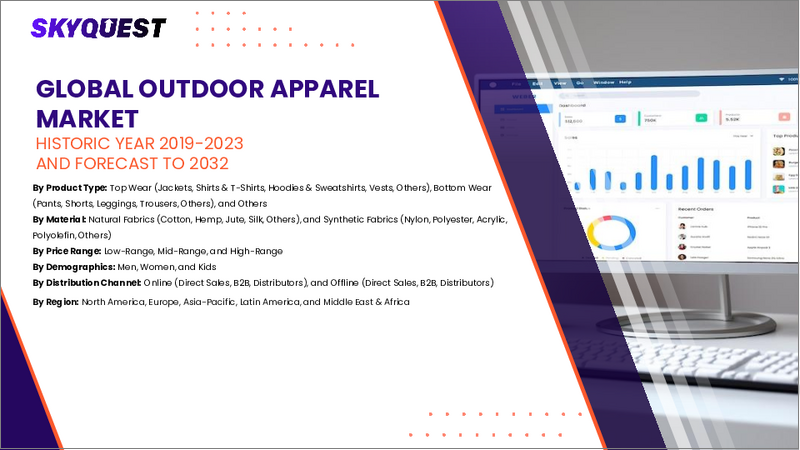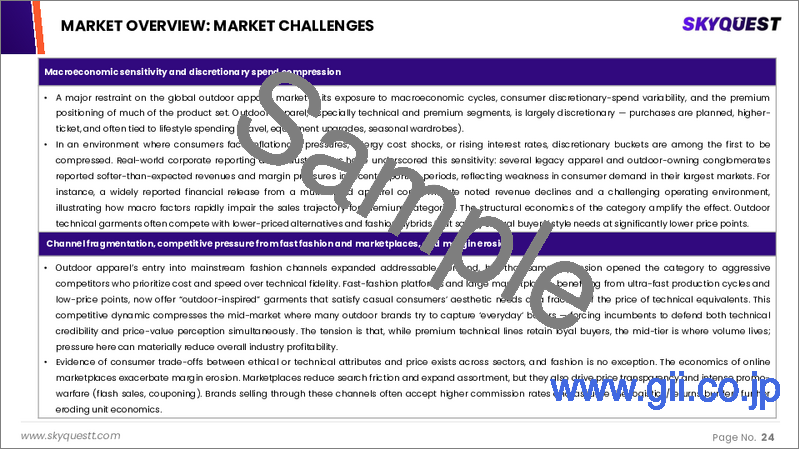|
|
市場調査レポート
商品コード
1646212
アウトドアアパレルの市場規模、シェア、成長分析:製品タイプ別、素材別、性別、価格帯別、流通チャネル別、地域別 - 産業予測 2025~2032年Outdoor Apparel Market Size, Share, Growth Analysis, By Product Type (Topwear, T-Shirts), By Material (Synthetic Fabrics, Natural Fabrics), By Gender-Based, By Price Range, By Distribution Channel, By Region - Industry Forecast 2025-2032 |
||||||
|
|||||||
| アウトドアアパレルの市場規模、シェア、成長分析:製品タイプ別、素材別、性別、価格帯別、流通チャネル別、地域別 - 産業予測 2025~2032年 |
|
出版日: 2025年01月27日
発行: SkyQuest
ページ情報: 英文 165 Pages
納期: 3~5営業日
|
全表示
- 概要
- 目次
アウトドアアパレル市場規模は2023年に157億2,000万米ドルとなり、予測期間(2025~2032年)のCAGRは5.4%で、2024年の165億7,000万米ドルから2032年には252億4,000万米ドルに成長する見通しです。
アウトドアアパレル市場は、アウトドアスポーツのパフォーマンスとユーザーエクスペリエンスを向上させるために設計された特殊素材を求める消費者の増加により、急速な成長を遂げています。これらの革新的な製品は、通常の衣服に比べて優れた身体保護機能を提供するため、消費者の需要が大幅に高まっています。世界の動向では、個人の間で身体活動やアウトドア・レクリエーションの傾向が高まっており、ハイキング、サイクリング、カヤックなど様々なアクティビティに参加する人が増えていることが、この市場の拡大をさらに後押ししています。さらに、子供たちがアウトドア・アドベンチャーに参加することに親が協力的になり、機能的でスタイリッシュなアウトドア・ウェアの需要に貢献しています。このような要因が組み合わさることで、アウトドアアパレル市場は今後数年間、継続的な成長が見込まれます。
目次
イントロダクション
- 調査の目的
- 調査範囲
- 定義
調査手法
- 情報調達
- 二次データと一次データの方法
- 市場規模予測
- 市場の前提条件と制限
エグゼクティブサマリー
- 世界市場の見通し
- 供給と需要の動向分析
- セグメント別機会分析
市場力学と見通し
- 市場概要
- 市場規模
- 市場力学
- 促進要因と機会
- 抑制要因と課題
- ポーターの分析
主な市場の考察
- 重要成功要因
- 競合の程度
- 主な投資機会
- 市場エコシステム
- 市場の魅力指数(2024年)
- PESTEL分析
- マクロ経済指標
- バリューチェーン分析
- 価格分析
- 原材料の分析
- 顧客と購買基準の分析
アウトドアアパレル市場規模:製品タイプ別
- 市場概要
- トップウェア
- Tシャツ
- ジャケット
- ベスト
- ボトムウェア
- パンツ
- ショートパンツ
- ズボン
- レギンス
- その他のアクセサリー
アウトドアアパレル市場規模:素材別
- 市場概要
- 合成繊維
- ポリエステル
- ナイロン
- 天然素材
- 綿織物
- 麻
- 竹
- ウール
アウトドアアパレル市場規模:性別
- 市場概要
- 男性
- 女性
- キッズ
アウトドアアパレル市場規模:価格帯別
- 市場概要
- 低価格
- 中価格
- 高価格
アウトドアアパレル市場規模:流通チャネル別
- 市場概要
- オンライン小売
- 電子商取引
- 会社所有のウェブサイト
- オフライン
- スーパーマーケット / ハイパーマーケット
- 専門店
- その他の小売業
アウトドアアパレル市場規模
- 北米
- 米国
- カナダ
- 欧州
- ドイツ
- スペイン
- フランス
- 英国
- イタリア
- その他欧州地域
- アジア太平洋地域
- 中国
- インド
- 日本
- 韓国
- その他アジア太平洋地域
- ラテンアメリカ
- ブラジル
- その他ラテンアメリカ地域
- 中東・アフリカ
- GCC諸国
- 南アフリカ
- その他中東・アフリカ
競合情報
- 上位5社の比較
- 主要企業の市場ポジショニング(2024年)
- 主な市場企業が採用した戦略
- 市場の最近の動向
- 企業の市場シェア分析(2024年)
- 主要企業の企業プロファイル
- 会社概要
- 製品ポートフォリオ分析
- セグメント別シェア分析
- 収益の前年比比較(2022~2024年)
主要企業プロファイル
- Patagonia(United States)
- Columbia Sportswear(United States)
- Arc'teryx(Canada)
- Salomon Group(France)
- Mammut Sports Group(Switzerland)
- Jack Wolfskin(Germany)
- L.L.Bean(United States)
- Mountain Hardwear(United States)
- Fjallraven(Sweden)
- Outdoor Research(United States)
- Rab(United Kingdom)
- Montbell(Japan)
- Black Diamond Equipment(United States)
- Berghaus(United Kingdom)
- Kathmandu(New Zealand)
結論と推奨事項
Outdoor Apparel Market size was valued at USD 15.72 billion in 2023 and is poised to grow from USD 16.57 billion in 2024 to USD 25.24 billion by 2032, growing at a CAGR of 5.4% during the forecast period (2025-2032).
The outdoor apparel market is experiencing rapid growth, driven by an increasing number of consumers seeking specialized materials designed to enhance performance and user experience in outdoor sports. These innovative products offer superior body protection compared to regular clothing, which has raised consumer demand significantly. Globally, a rising trend of physical activity and outdoor recreation among individuals is further propelling this market expansion, as more people engage in various activities such as hiking, biking, and kayaking. Additionally, parents are becoming more supportive of their children participating in outdoor adventures, contributing to the demand for functional and stylish outdoor wear. This combination of factors positions the outdoor apparel market for continued growth in the coming years.
Top-down and bottom-up approaches were used to estimate and validate the size of the Outdoor Apparel market and to estimate the size of various other dependent submarkets. The research methodology used to estimate the market size includes the following details: The key players in the market were identified through secondary research, and their market shares in the respective regions were determined through primary and secondary research. This entire procedure includes the study of the annual and financial reports of the top market players and extensive interviews for key insights from industry leaders such as CEOs, VPs, directors, and marketing executives. All percentage shares split, and breakdowns were determined using secondary sources and verified through Primary sources. All possible parameters that affect the markets covered in this research study have been accounted for, viewed in extensive detail, verified through primary research, and analyzed to get the final quantitative and qualitative data.
Outdoor Apparel Market Segments Analysis
Global Outdoor Apparel Market is segmented by Product Type, Material, Gender-Based, Price Range, Distribution Channel and region. Based on Product Type, the market is segmented into Topwear, T-Shirts, Jackets, Vests, Bottomwear, Pants, Shorts, Trousers, Leggings and Other Accessories. Based on Material, the market is segmented into Synthetic Fabrics and Natural Fabrics. Based on Gender-Based, the market is segmented into Men, Women and Kids. Based on Price Range, the market is segmented into Low, Medium and High. Based on Distribution Channel, the market is segmented into Online Retail and Offline. Based on region, the market is segmented into North America, Europe, Asia Pacific, Latin America and Middle East & Africa.
Driver of the Outdoor Apparel Market
The Outdoor Apparel market is significantly driven by a growing enthusiasm for nature and a desire to acquire skills for leading healthier, fulfilling lives, prompting an increasing number of individuals to engage in outdoor activities. This surge in sports and fitness engagement is fueling the demand for outdoor clothing. Consumers' preference for specialized apparel that enhances comfort and quality emerges as a crucial factor in their purchasing decisions. Urban consumers, who increasingly favor branded and sustainable products, represent a substantial portion of the outdoor wear market, further contributing to its expansion and evolution in response to shifting consumer preferences.
Restraints in the Outdoor Apparel Market
The growth of the global outdoor apparel market is facing significant challenges due to the increasing production of counterfeit products by local manufacturers. These fake goods disrupt the distribution channels and adversely affect the overall market development. Moreover, the prevalence of counterfeit items not only hampers the manufacturing of authentic products but also negatively impacts national economies by diverting sales away from legitimate businesses. Consumers often find themselves purchasing inferior-quality items at inflated prices, leading to dissatisfaction and distrust in the market, ultimately stifling innovation and hindering the potential for genuine brands to thrive.
Market Trends of the Outdoor Apparel Market
The outdoor apparel market is witnessing a transformative trend as consumers increasingly prioritize value-added clothing enriched with advanced technology and multifunctionality. Urban dwellers, comprising a significant demographic, are drawn to stylish and sustainable options, favoring well-known brands that prioritize environmental responsibility. The demand for innovative products crafted from recycled materials reflects a growing eco-conscious mindset among consumers. This trend is further fueled by the influx of cutting-edge designs that seamlessly blend performance with contemporary aesthetics. As awareness around chic, active lifestyles rises, the outdoor apparel market is positioned for substantial growth across various distribution channels, catering to these evolving customer preferences.
Table of Contents
Introduction
- Objectives of the Study
- Scope of the Report
- Definitions
Research Methodology
- Information Procurement
- Secondary & Primary Data Methods
- Market Size Estimation
- Market Assumptions & Limitations
Executive Summary
- Global Market Outlook
- Supply & Demand Trend Analysis
- Segmental Opportunity Analysis
Market Dynamics & Outlook
- Market Overview
- Market Size
- Market Dynamics
- Drivers & Opportunities
- Restraints & Challenges
- Porters Analysis
- Competitive rivalry
- Threat of substitute
- Bargaining power of buyers
- Threat of new entrants
- Bargaining power of suppliers
Key Market Insights
- Key Success Factors
- Degree of Competition
- Top Investment Pockets
- Market Ecosystem
- Market Attractiveness Index, 2024
- PESTEL Analysis
- Macro-Economic Indicators
- Value Chain Analysis
- Pricing Analysis
- Raw Material Analysis
- Customer & Buying Criteria Analysis
Global Outdoor Apparel Market Size by Product Type & CAGR (2025-2032)
- Market Overview
- Topwear
- T-Shirts
- Jackets
- Vests
- Bottomwear
- Pants
- Shorts
- Trousers
- Leggings
- Other Accessories
Global Outdoor Apparel Market Size by Material & CAGR (2025-2032)
- Market Overview
- Synthetic Fabrics
- Polyester
- Nylon
- Natural Fabrics
- Cotton Fabrics
- Hemp
- Bamboo
- Wool
Global Outdoor Apparel Market Size by Gender-Based & CAGR (2025-2032)
- Market Overview
- Men
- Women
- Kids
Global Outdoor Apparel Market Size by Price Range & CAGR (2025-2032)
- Market Overview
- Low
- Medium
- High
Global Outdoor Apparel Market Size by Distribution Channel & CAGR (2025-2032)
- Market Overview
- Online Retail
- Ecommerce
- Company Owned Website
- Offline
- Supermarket/Hypermarket
- Speciality Stores
- Other Retail Formats
Global Outdoor Apparel Market Size & CAGR (2025-2032)
- North America (Product Type, Material, Gender-Based, Price Range, Distribution Channel)
- US
- Canada
- Europe (Product Type, Material, Gender-Based, Price Range, Distribution Channel)
- Germany
- Spain
- France
- UK
- Italy
- Rest of Europe
- Asia Pacific (Product Type, Material, Gender-Based, Price Range, Distribution Channel)
- China
- India
- Japan
- South Korea
- Rest of Asia-Pacific
- Latin America (Product Type, Material, Gender-Based, Price Range, Distribution Channel)
- Brazil
- Rest of Latin America
- Middle East & Africa (Product Type, Material, Gender-Based, Price Range, Distribution Channel)
- GCC Countries
- South Africa
- Rest of Middle East & Africa
Competitive Intelligence
- Top 5 Player Comparison
- Market Positioning of Key Players, 2024
- Strategies Adopted by Key Market Players
- Recent Developments in the Market
- Company Market Share Analysis, 2024
- Company Profiles of All Key Players
- Company Details
- Product Portfolio Analysis
- Company's Segmental Share Analysis
- Revenue Y-O-Y Comparison (2022-2024)
Key Company Profiles
- Patagonia (United States)
- Company Overview
- Business Segment Overview
- Financial Updates
- Key Developments
- Columbia Sportswear (United States)
- Company Overview
- Business Segment Overview
- Financial Updates
- Key Developments
- Arc'teryx (Canada)
- Company Overview
- Business Segment Overview
- Financial Updates
- Key Developments
- Salomon Group (France)
- Company Overview
- Business Segment Overview
- Financial Updates
- Key Developments
- Mammut Sports Group (Switzerland)
- Company Overview
- Business Segment Overview
- Financial Updates
- Key Developments
- Jack Wolfskin (Germany)
- Company Overview
- Business Segment Overview
- Financial Updates
- Key Developments
- L.L.Bean (United States)
- Company Overview
- Business Segment Overview
- Financial Updates
- Key Developments
- Mountain Hardwear (United States)
- Company Overview
- Business Segment Overview
- Financial Updates
- Key Developments
- Fjallraven (Sweden)
- Company Overview
- Business Segment Overview
- Financial Updates
- Key Developments
- Outdoor Research (United States)
- Company Overview
- Business Segment Overview
- Financial Updates
- Key Developments
- Rab (United Kingdom)
- Company Overview
- Business Segment Overview
- Financial Updates
- Key Developments
- Montbell (Japan)
- Company Overview
- Business Segment Overview
- Financial Updates
- Key Developments
- Black Diamond Equipment (United States)
- Company Overview
- Business Segment Overview
- Financial Updates
- Key Developments
- Berghaus (United Kingdom)
- Company Overview
- Business Segment Overview
- Financial Updates
- Key Developments
- Kathmandu (New Zealand)
- Company Overview
- Business Segment Overview
- Financial Updates
- Key Developments






